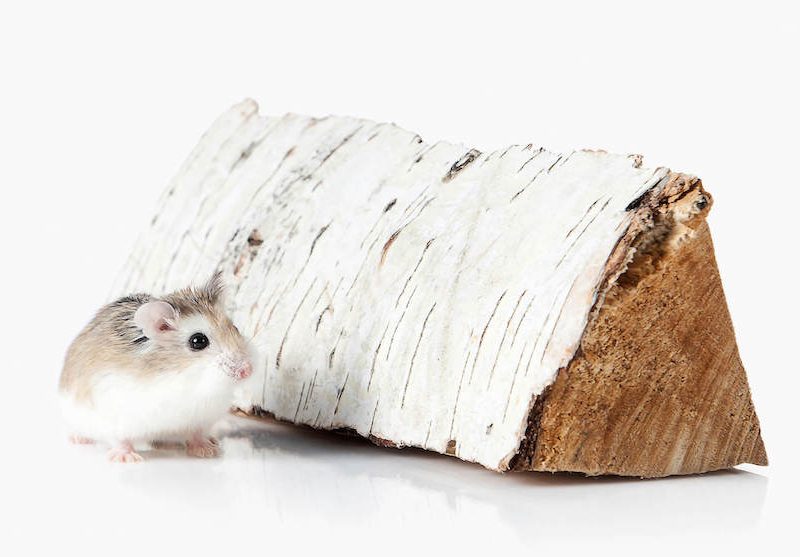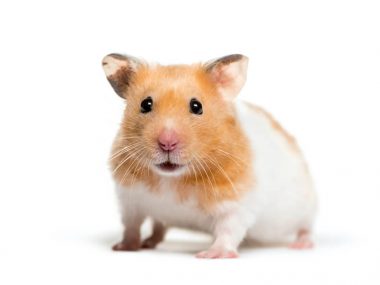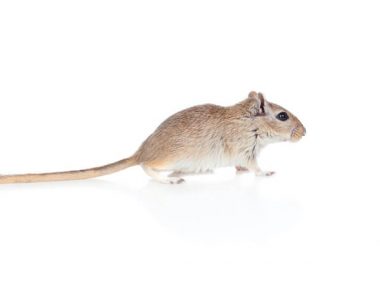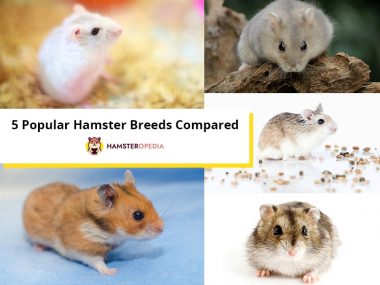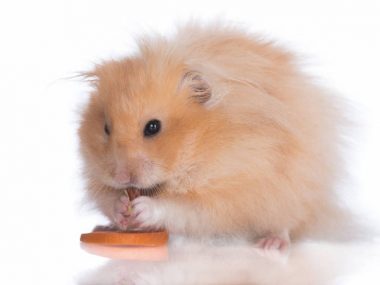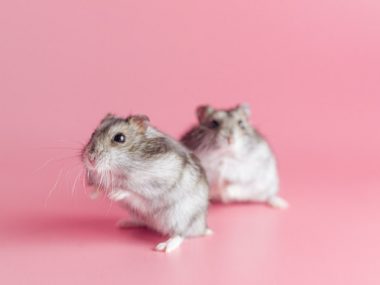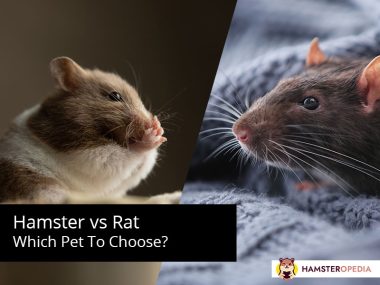How about a tiny hamster that can fit in a tablespoon? We’ve got one for you that you definitely want to check out. The Roborovski dwarf hamster goes back MILLIONS of years! Yet, it still makes the perfect pet for today’s kiddos!
Table of Contents
What Is A Roborovski Dwarf Hamster?
Roborovski Dwarfs (Phodopus roborovskii) are the smallest of all hamster species. These hamsters are also known as “Robo” for short. They belong to the Phodopus genus, which also includes other dwarf hamster species that include the Campbell and Dzhungarian.
Where Did Roborovski Dwarf Hamsters Come From?
Robo Dwarfs are native to a region of the world known as the Palearctic. This area includes Tibet, Mongolia, Kazakhstan, and northern China. Robos thrive in the desert and also the mountains within their geographic range.
The University of Michigan’s Museum of Zoology provides an intriguing look into how far back Robos go historically. Their breed profile for the Robo mentions this hamster’s origin began 10,000 years ago when it began to diverge as a subspecies from Phodopus sungorus (Dzhungarian, Striped Desert, Striped Hairy-Footed.) Through painstaking scientific testing, evidence of hamsters in the Palearctic region revealed their presence as far back as 12 million years ago.
Robo hamster ancestral lineage was traced back to Kazakhstan’s Zaisan Basin. Robos evolved from an ancestral genus about 0.8 to 1 million years ago because of the fluctuating climate. As a result, the hamsters not only changed to adapt to their environment, but they also began to migrate and spread.
The first domestication of Roborovski hamsters is noted in a research study (Decorative Forms of Hamsters of the Genus Phodopus (Mammalia, Cricetinae): Analysis of Genetic Lines Distribution and Features of Hair Changes.) The study mentions Robos were not domesticated until 1970 by the Moscow Zoo.
The study goes on to mention members of an expedition (Central Asian Expedition, Institute of Cytology and Genetics of the Siberian Branch of the Soviet Academy of Sciences in the Zaisan Basin) brought Roborovski hamsters to the Moscow Zoo, where the hamsters were bred within a captive environment. Eventually, Robos made their way to other zoos in England and the U.S. Then these hamsters have slowly made their way into the pet trade industry.
Roborovski Dwarf Hamster Characteristics and Traits
There’s no mistaking a Robo because of its tiny, compact size. They are highly energetic and a bit feisty to handle. First-time (or children) pet owners may not find the Robo to be a suitable starter pet. Nonetheless, they have a unique charm to pet owners who don’t mind a bit of a challenge!
Robo Dwarf Hamster At A Glance
- Coat: short-hair
- Colors: cream, cinnamon, sandy, white
- Patterns: dominant spot, roan
- Self or Agouti: agouti
- Eyes: black, red
- Size: 2-3 inches
- Lifespan: 19-40 months
- Diet: herbivore, granivore
- Sexual maturation: 2 months (females,) 2 ½ months (males)
- Temperament: high energy
- Level of care: moderate to extensive
Robo Hamster Coat Characteristics
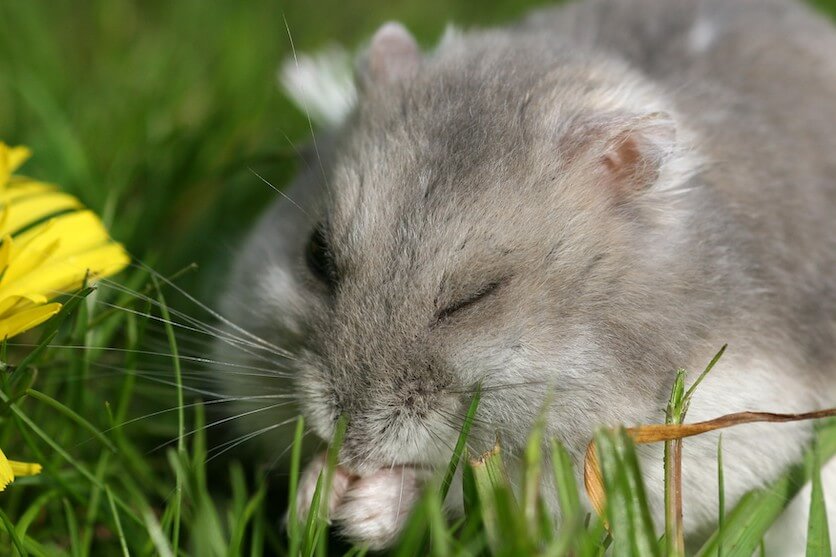
Robo hamsters are short-haired and are typically predominantly sand-colored; some may have a mottling (also known as “pied”) in color with different shades. When it comes to the pattern of their coat, they will either be roan or dominant spot and agouti. You may hear Roborovski dwarf hamsters described with other colors, patterns, or eye colors. Hybrid variations from selective breeding bring these additional features out in a Robo.
- Roan
- Predominantly cream or white
- Head may be heavily colored or have no color
- Head coloring tapers off, becoming pale or disappearing towards the tail
- May have red eyes
- Dominant Spot
- Predominantly white with random patches or spots of color
- Agouti
- Crescent shape is present on the cheek
- Abdomen area is lighter
Eyes, Ears, and Tail Characteristics
While other hamster species may have varied eye colors, the eyes of a Robo will always be black. Just above the eyes are white markings that mimic eyebrows. The base of their ears is lighter and may even appear white. Their tail is very tiny and almost stubby looking.
Roborovski Hamster Lifespan
The lifespan of a Robo is quite short when compared to other pets such as dogs, cats, birds, etc. A healthy Robo can live up to 40 months (about 1 year and 4 months) if raised in an ideal environment and well-cared for.
A Robo is extremely fast and won’t hesitate to jump out of a pair of well-cupped hands. Finding them once loose can be a challenge. Having such a delicate skeletal structure, falls can cause severe injury or be fatal, and because of such a high risk of getting hurt, this hamster species is not ideal for children, homes with dogs or cats, or those who are elderly.
Other factors play a role in the longevity of any hamster, such as genetics, the level of care they are receiving, and the environment.
Roborovski Dwarf Hamster Size
Roborovski Dwarfs are the smallest hamster species. They barely go past 2 inches in length and weigh no more than half an ounce. To give you perspective on just how small they are, they could fit in a tablespoon! Their super-compact size makes them a perfect pet for those who don’t have a lot of living space. Although a Robo can easily be described as a “pocket-pet,” they by no means fit the bill as a portable pet.
Roborovski Dwarf Hamster Behavior
These little hamsters have a predisposition of being extremely anxious and constantly stressed. Because of this, handling them can be a challenge. Compared to the other hamster species, Robos are far more energetic and have difficulty acclimating to new environments.
In a breed profile for Robo hamsters published by the University of Michigan Museum of Zoology, it notes that this particular hamster species exhibits model behavior for research studies in relation to ADHD (attention deficit hyperactivity disorder.)
Although some hamsters may hibernate under certain conditions, Robos do not. Even in the wild, these little guys do not hibernate to conserve energy when food is scarce. They do become a little bit less active from about February to March.
Do Roborovski Dwarf Hamsters Bite?
When any animal is anxious or afraid, it may bite. Roborovski dwarf hamsters that have not been properly handled and tamed are very prone to bite. This is important to keep in mind, especially if you have small children.
Do Robo Dwarf Hamsters Like To Be Held?
Robos require more handling compared to other hamster species. Unfortunately, even if one has been thoroughly handled and tamed as much as it could be, it will still attempt to jump out of your hands.
How To Tame A Roborovski Hamster
Robo hamsters are the hardest of all hamster breeds to tame. Perhaps it’s because of their hypervigilant state of mind. Should you be entertaining the idea of getting one, the first bit of advice we can impart to you is you are going to need a lot of patience.
Taming and handling sessions need to be timed just right, be consistent, and be done with the expectation that you may be bitten. Keep in mind hamsters are nocturnal (active at night) so trying to tame them during the day isn’t ideal. Use the evenings to handle and tame.
Here’s how to tame a robo hamster step-by-step:
- After bringing your hamster home, allow it to get used to its environment for the first few days. Do not attempt to pick it up, but talk to it daily. Your voice is one of the first things it will learn to recognize.
- Place a small piece of your clothing (sock, hanky, etc.) inside the cage to get it acquainted with your scent.
- After a few days, it’s time to start handling.
- Wash your hands before and after each handling session.
- Talk to your hamster when placing hands into the cage. Your hands should be cupped. Never surprise your hamster by grabbing it.
- Handling your hamster should be done at floor level and be within a confined area. Also, handling must be done outside of the cage.
- Use treats to provide positive reinforcement.
Roborovski Hamster Care
Before taking your new hammie home, you’ll have to prep their environment. This means buying a suitable cage, some hamster accessories, and stocking up on suitable foods.
Roborovski Hamster Cage
Dwarf hamsters may not need a large cage like a Syrian hamster would but should still have ample room to be active in. There are many choices of hamster cages on the market. No matter your budget, it’s easy to find something suitable.
Cage Accessory Must-Haves
- Nesting box
- Bedding (cedar and pine shavings should never be used)
- Wheel
- Water bottle
- Food bowl
- Toys
Cage Placement
Good
- An area with temperatures between 64-79 degrees (F) (17-26 C)
- Protected from children and pets
- On a surface that is supportive and sturdy
Bad
- In drafts or areas prone to cold/heat; near windows, doors, fireplaces, vents, on top of appliances
- Next to loud noises (tv, stereo, etc.)
Robo Dwarf Hamster Food
Finding the best Roborovski hamster food is as easy as selecting a good-quality commercial food designed for hamsters in your local pet store. Robos are herbivores and granivores. They eat insects, plant matter, nuts, seeds, and grains. The majority of their diet (70-90%) should be seeds and plant matter. Young hamsters eat more than an adult would. Also, come wintertime, expect to feed your hamster a little more.
Toxic Foods To Avoid:
- Alcohol
- Caffeine (chocolate, tea, coffee, etc.)
- Citrus (oranges, lemons, limes, grapefruit, etc.)
- Nightshade vegetables (potatoes, tomatoes)
- Onions
- Garlic
Are Roborovski Dwarf Hamsters Good Pets?
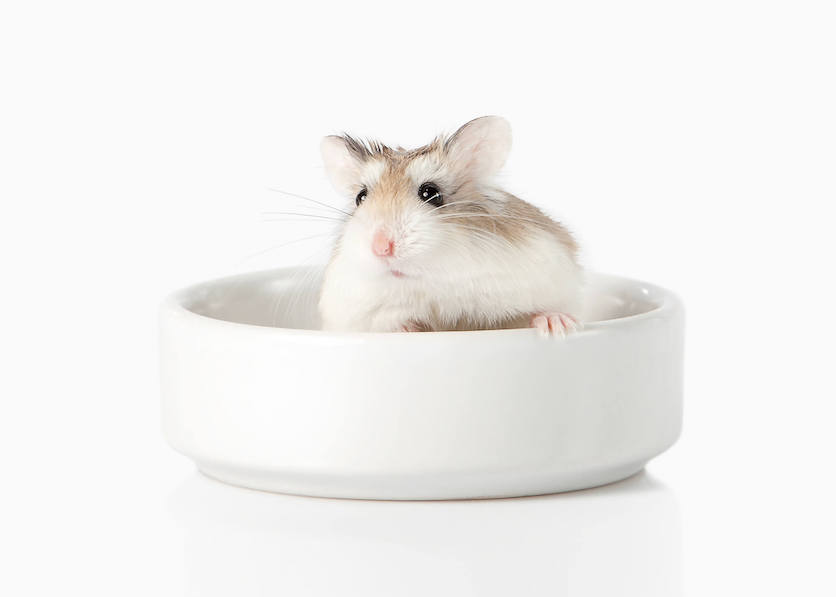
Roborovski hamster species is not the best option for those who want a super-cuddly, chilled-out pet. Robos require a lot of handling and patience and, even then, may not be as docile as hoped.
Do Roborosvki Hamsters Need To Be In Pairs?
These hamsters are solitary and do best in a cage without other hamsters. When attempting to pair them, they can become aggressive or just the opposite (retreating.) Robos are notorious for freezing when exposed to stressful stimuli such as introducing a cage mate.
How Much Does A Roborovski Hamster Cost?
Robo hamsters are typically only available through a breeder because of their “newness” to the pet market. When you do find one, expect to pay more.
- Robo hamster: $20-$40 (USD)
- Cage: $15 – $300 (USD)
- Accessories (wheel, nesting box, bedding:) $30 – $65 (USD)
- Food: $5 – $15 (USD)
Robos Need Special Attention
As cute as these hamsters are, they may not be exactly the cuddliest and friendliest hamster breed on the market. Do your homework before buying any pet. They may be tiny, but the responsibility is much larger and should be for the lifetime of the pet.
